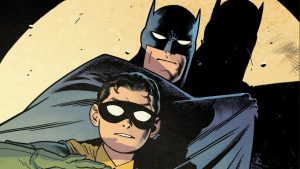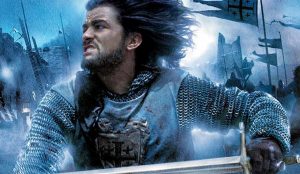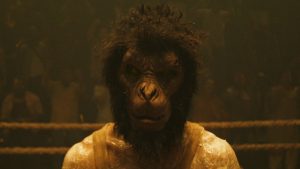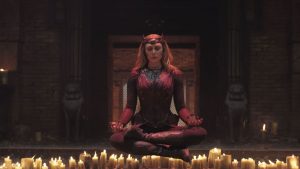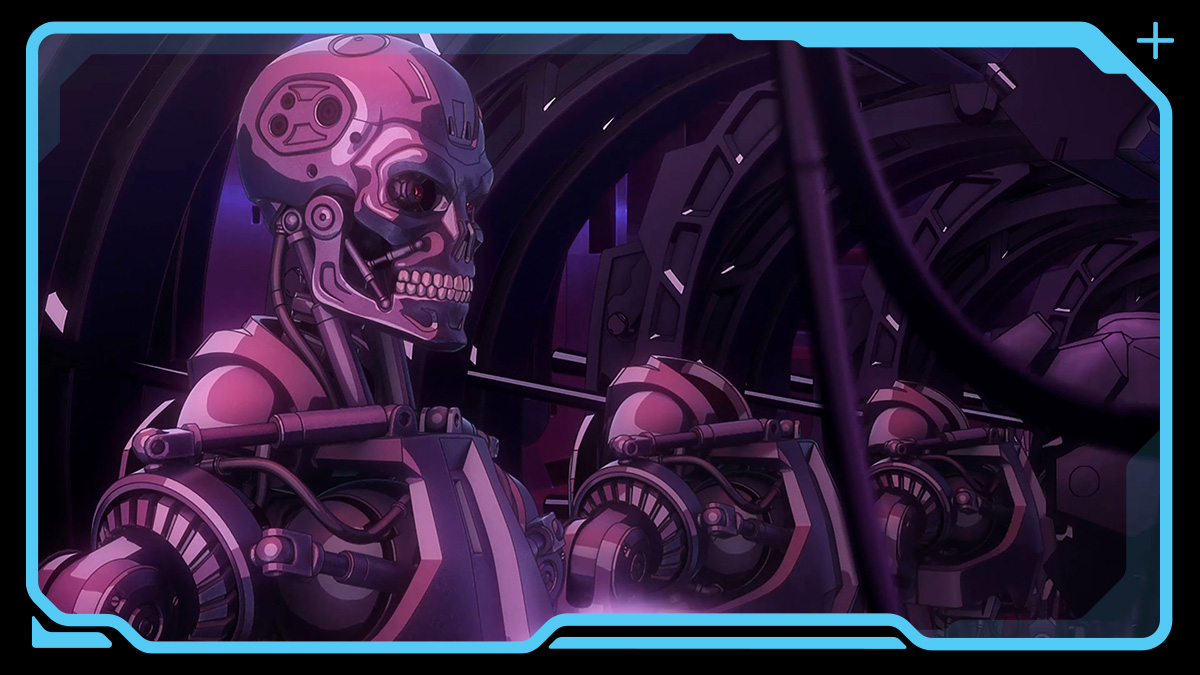
This article is presented by
The threat of artificial intelligence has evolved from a radical science-fiction fantasy into a very real concern that continues to change the world with each passing day. Technology and entire industries are being redefined by mankind’s growing reliance on artificial intelligence. The prospect of a technological singularity and an A.I.-driven robot apocalypse may have seemed like cinematic make-believe back when James Cameron and Gale Anne Hurd’s The Terminator was released in 1984. However, four decades later, techno-armageddon feels more plausible than ever, and it’s the perfect time to revisit a franchise that’s as totemic as Terminator.
There have been Terminator comics, video games, and even a series of novels, but it has proven to be a challenge to properly cultivate the right cyberpunk dystopian energy that’s become synonymous with the franchise. Acclaimed animation studio, Production I.G, in association with Skydance Television and Netflix Animation, have neurolinked their resources together to create Terminator Zero, the perfect Terminator anime series that not only respects its source material but also bravely pushes it forward to unprecedented places.
Production I.G’s Legacy as Anime Visionaries
A gritty, action-heavy property like Terminator may seem tailor-made for an anime makeover, but there are dozens of different art styles and aesthetics from contrasting animation studios to consider. Anime is not a one-size-fits-all medium, and plenty of projects fail before they even get moving because a certain story isn’t aligned with the right studio.
Production I.G has been in the business for over 35 years and has more than 100 unique anime productions to its name. This includes highly-celebrated series such Haikyu!!, Cromartie High School, and this year’s breakout hit, Kaiju No. 8, but Production I.G is especially skilled when it comes to futuristic cyberpunk dystopian sagas. Ghost in the Shell and PSYCHO-PASS are two of Production I.G’s biggest properties, and they’re practically synonymous with mature cyberpunk thrillers. Zillion, Production I.G’s inaugural series, even featured a remarkably Terminator-esque concept where a race of warrior cyborgs attempt to eradicate all humans in the future.
Production I.G has built a name for itself as the anime studio to turn to for mature storytelling, complex world-building, and bleak themes brought to life with clean, impressive visuals and a dark animation style (excluding their sports anime). It’s Production I.G that Quentin Tarantino recruited for Kill Bill: Vol. 1’s ultra-violent anime sequence, and the studio has become well-versed in re-contextualizing established franchises through an anime lens.
One of Production I.G’s most successful series, Guilty Crown, focuses on a scourge known as the Apocalypse Virus that spreads through Japan, causes chaos, and creates a scenario that’s reminiscent of Terminator’s Judgment Day, only if Skynet were successful in their oppressive agenda. In many ways, Production I.G’s past works and the recurring themes that they’ve routinely explored have acted as the perfect preparation for a project like Terminator Zero. It’s the culmination of nearly four decades of cutting-edge anime storytelling, as if the studio has been training for this moment, just like Terminator’s Kyle Reese.
Koichi Bansho, Production I.G’s animation producer, celebrates how the series feels very in sync with past Production I.G projects. “We were incredibly fortunate to have Atsushi Takeuchi and Yukinobu Tsuneki, renowned for their work on the Ghost in the Shell and PSYCHO-PASS series, as part of the mecha design team for Terminator Zero,” says Bansho. Their expertise and contribution to building the sci-fi aesthetics for this title are unparalleled.”
Mattson Tomlin, Terminator Zero’s showrunner and sole writer (who’s also co-writer on The Batman Part II with Matt Reeves), was already a fan of Production I.G’s signature brand of anime sci-fi melodrama. Tomlin was excited to work with Production I.G when he began scripting an animated Terminator series. “They’re at the very top of the list of dream partners to work with, so for me, it was a matter of making sure that I was writing material that played to their incredible strengths,” says Tomlin. “The partnership between myself and director [Masashi] Kudo was very much built on challenging each other to go higher and harder and do our very best work.”
Fleshing Out a Cyberpunk Dystopia
One of Terminator Zero’s most exciting and original qualities is that it doesn’t just depict a new Terminator story, but one that’s specifically set in Japan. This presented some curious challenges to both Production I.G and Tomlin regarding the execution of his story and how to flesh out this world.
“The fact that the story is set in Japan and has a different storyline from the original John Connor and Sarah Connor plot seemed like the perfect way to expand the franchise into a new art form like anime,” outlines Kudo, who directs all eight Terminator Zero episodes. “What I found appealing was how changing the medium allowed for different storytelling approaches and the opportunity to offer new surprises to long-time fans of the franchise. I also wanted to bring a Japanese perspective when it comes to the horror of nuclear weapons.”
Tomlin elaborates on this: “I quickly realized there was a huge opportunity within the Terminator franchise—the films take place entirely in the United States, and a huge portion of that on the U.S./Mexico border. Very little is stated about what’s going on in the rest of the world. For me, setting it in Japan allowed for a level of creative freedom where I could tell the story that was calling to me.”
Production I.G is uniquely suited to tackle this animated tale of a futuristic technological dystopia. However, Tomlin is no stranger to A.I. takeover stories after writing and directing Hulu’s Mother/Android, a film that tackles an Orwellian world where predatory artificial intelligence runs amok. Tomlin reveals that dystopian worlds and technology’s overbearing advancements in society have always been one of his greatest fascinations. “I think we’re living in an extraordinarily frightening time,” Tomlin says. “Two years ago, the idea of artificial intelligence still felt like science fiction. Now, anytime I scroll through my feed and I see a photograph, I have to ask myself if it’s a real photograph or something conjured by A.I.
“I think if there is a war against the machines, it’s not going to be fought through Terminators and time displacement machines; it’s going to be fought through misinformation, bank accounts, and phishing scams. All that is to say, I think the themes in the show and in the franchise at large couldn’t be more relevant to this time we’re in.”
Kudo agrees but stresses the human element in all of this. “I believe that by portraying characters living in a dystopian world, it is possible to highlight the negative aspects of human nature and also express love. I also think that having the juxtaposition of technology’s overbearing advances with human physicality and spirituality can make a story very compelling.”
The prospect of an A.I. uprising holds fascinating storytelling potential for Tomlin and the Production I.G team. However, Terminator is also a franchise that Tomlin holds near and dear to his heart—and one that brings out his inner child. “I’m a huge fan of the films and know them all well. I wanted to make sure that Terminator Zero felt like it was treading on new ground without being totally divorced from the look, feel, and vibe of the original films. [James] Cameron is able to thread so many different tones,” Tomlin says. “All of his films have these tonal maneuvers that I always had to keep in mind; it’s not just one thing, and to lean too far into large-scale sci-fi risks losing the tenderness that audiences might expect without even knowing they’re expecting it.”
Kudo holds a similar degree of reverence for the franchise that was channeled into the production. “I watched the first and second films in one viewing and then revisited the third and fourth films, all the way to Genisys and Dark Fate. I used the second film, in particular, as a reference for mechanical details, such as the Terminator and the hunter-killers, and the fourth film for details about the dystopian world. I also felt that merely ‘tracing’ the surface was not enough, so I researched and analyzed James Cameron’s visual philosophy and directorial techniques that underlie the first two Terminator films. This also involved rewatching his other films, such as Aliens and Titanic, and reading his books.”
Evolving a Foundational Sci-Fi Franchise
Terminator Zero has a distinct visual language when it comes to its action sequences and what audiences have come to expect from a Terminator showdown. Kudo explains that there’s a delicate balance when referencing past Terminator iconography and providing their own spin on these staples. “This time, the story is set in Japan. The Terminator infiltrates by disguising as a human, but a giant white male would be too conspicuous in Japan, especially in the ’90s,” he says. “The Terminator had to be designed with a Japanese body shape. Therefore, the ‘terrifying’ fear factor of the Japanese Terminator will be different from any of the previous Terminators. I think the viewer will enjoy the difference.”
Tomlin reinforces this: “I wrote myself a set of guidelines for what makes an episode in this world,” he explains. “When it came to the action, it was important that it was always emotionally charged, with clear life-or-death stakes—which is relatively easy when you’re up against a killer cyborg who feels no pain… But each action sequence needed to be imbued with a sense of horror, dread, or some sense of violent beauty.”
Terminator and anime fans alike will no doubt love what Production I.G has in store for them with Terminator Zero. The team has developed a fresh take on Terminator that crafts a world that’s detailed enough to sustain multiple seasons of storytelling, if need be, just like Cameron’s original film. Kudo, for instance, highlights how the fear and unease from 1995’s Tokyo subway sarin attack and the Great Hanshin-Awaji Earthquake course through the series. Tomlin also reveals that Kyle Reese’s speech to Sarah Connor in the first movie regarding the Terminator’s unstoppable nature became a major moment of inspiration for the series’ production. “That distillation of the Terminator as an elemental force, something to dread, something that will never stop, became a North Star for me while writing to bring the series back to that slant of horror that the first film has. This dictated the look, the feel, the sound of the Terminator featured in season one.”
Terminator Zero is a testament to anime’s power as a limitless storytelling medium and why more franchises should turn to it as a way to extend their brand. After repeated false starts of kickstarting new chapters in the grander Terminator series, Terminator Zero finally hacks into the right formula. “My goal was to create a show that is essential viewing for any Terminator fan,” Tomlin says. Terminator Zero’s eight episodes will delight both seasoned Terminator fans and franchise newcomers. However, its success could also open the door for other mature anime series based on successful film franchises. Terminator Zero’s success means that there’s no reason why there can’t be a RoboCop, Alien, or even a Mad Max anime as Netflix continues to flesh out its impressive adult animation slate.
Terminator Zero comes to Netflix on Aug. 29.
The post Terminator Zero: How Production I.G Brought the Dystopian World of Terminator to Anime appeared first on Den of Geek.
